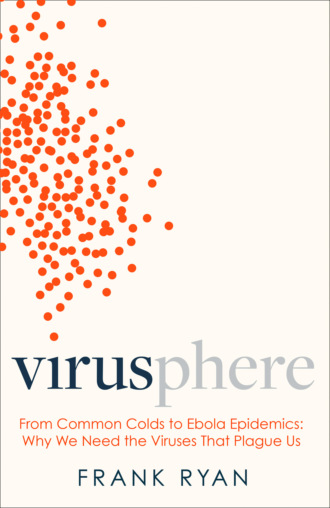
Полная версия
Virusphere: What doesn’t kill you makes you stronger
In this book we shall explore the truly strange, and intriguing, world of viruses. We might make a start by dispelling a common misconception; many people tend to confuse viruses with bacteria. This is perfectly understandable since viruses, like bacteria, cause many of the common ailments that afflict us in our ordinary lives, and particularly so the fevers that beset the lives of our children. Family doctors deal with these common ailments on a day-to-day basis, and they tend to treat them in similar ways, with antibiotics for bacterial illnesses and vaccination programmes or antiviral drugs aimed at protecting kids from the common viral infections. It is little wonder that people are apt to confuse viruses with bacteria. What then is the difference between the two?
In fact there are major differences between bacteria and viruses. The most obvious difference is one of scale: most viruses are much smaller than bacteria. We readily grasp this if we take a closer look at what is going on during those coughs and sneezes that we recognise as the harbingers of that bothersome cold. While a few other viruses can cause an illness resembling a cold, the majority of colds are caused by a particular virus, which goes by the name of ‘rhinovirus’. If one harks back to the sneezing, snuffling and nose-blowing that are the familiar symptoms of that developing cold, the name rhinovirus is apt, since ‘rhino’ derives from the Greek word, rhinos, for nose. Rhinoviruses are the commonest virus infections to afflict humans worldwide, with a seasonal peak in the autumn and early winter. The more we learn about the rhinovirus, the more we witness how well-suited it is to its natural environment, and to its life cycle of infectious behaviour and spread.
The rhinovirus is exceedingly tiny, at about 18 to 30 nanometres in diameter. A nanometre, or nm, is one-thousand-millionth of a metre. This clearly tells us that a single rhinovirus organism – it is referred to as a ‘virion’ – is absolutely minuscule. In the evolutionary system of classification known as ‘taxonomy’, rhinoviruses are classed as a genus within the family of the ‘picornaviruses’, a word derived from pico for small, and rna, because the rhinovirus genome is made up of the nucleic acid RNA rather than the more familiar DNA. Let us put aside any discussion of these genetic molecules for the moment, but we shall return to consider some remarkable implications of RNA-based viral genomes in subsequent chapters.
Returning to the differences in scale between viruses and bacteria, rhinoviruses are far too small to be seen under the ordinary laboratory light microscope. The virions can only be visualised under the phenomenal magnification of the electron microscope, when they appear to be roughly spherical in shape, resembling tiny balls of wool. In fact, if we examine the individual virions more closely under the electron microscope, we see that they are not really spheres but have multifaceted surfaces, rather like cut diamonds. In the technical jargon, the multifaceted surface of the rhinovirus is the viral ‘capsid’, which is the viral equivalent of a human cell’s enclosing membrane. This capsid has a striking mathematical symmetry comprising 20 equilateral triangles. All viruses have genomes, made up of either DNA or its sister molecule, RNA. The protein capsid acts as a protective shell that encloses the viral genome. It is the capsid that gives rhinoviruses their quasi-crystalline appearance, known as ‘icosahedral’ symmetry – the term is simply the Greek for ‘twenty-sided’. The multifaceted symmetry is not comprised of diamantine crystal, however, but constructed by a biochemical protein assembly.
Microbiologists had long recognised the presence of viruses before the electron microscope was invented. They found ways of detecting the presence of viruses from their effects on host cells, and they could even count their precise numbers from their cytopathic effects in cultures. It will come as no surprise to discover that the best cultures for growing rhinoviruses are cells derived from the human nasal lining, or the lining of the windpipe, or trachea. We are equally unsurprised to learn that the best temperature at which to culture cold viruses is between 33°C and 35°C, which is the temperature found within our human nostrils on a cold autumnal or winter’s day.
Rhinoviruses are highly adapted for survival in their host environment. They are also highly adapted to infect a specific host. This became apparent when scientists attempted to infect laboratory animals, including chimpanzees and gibbons, with a variety of different subtypes of rhinovirus that readily infected humans. They could not replicate the symptoms of a typical cold in any of the animals. From this we glean an important lesson about viruses: the rhinovirus is most particular when it comes to its choice of host, which is exclusively Homo sapiens. This has a pertinent significance; it means that human infection is vitally important to virus survival. Only through human to human contagion can the virus be passed on and breed new generations of rhinovirus. We are the natural reservoir of the cold virus.
But a moment or two of reflection on such exclusivity provokes a tangential thought – and a pertinent question. These minuscule polyhedral balls have no obvious means of locomotion. How can they possibly move about through our human population to effortlessly spread their infection across national and even international boundaries?
In fact, we already have the answer: it is implied in the very title of this chapter. Why do we cough and sneeze? We do so because this is what happens when our noses, throats and windpipe passages feel irritated. It is part of the natural defences against foreign material entering passages where it could block our airways and, implicitly, obstruct them and threaten our breathing. What rhinoviruses do is to provoke the same physiological responses by irritating the linings of our nasal passages. The viruses spread from person to person because they are explosively ejected into the ambient air with every cough and sneeze, to be inhaled and subsequently infect new hosts. And here, once again, we learn something vitally important about viruses. The viruses do not need any mechanism of locomotion because they hitch a ride on our own locomotion, and everywhere we go, we further oblige them by spreading their contagion by coughing and sneezing.
How clever, we are inclined to think, are viruses!
But viruses could not possibly be clever. They are far too simple to be capable of thinking for themselves. We are instead confronted by another of the numerous enigmas in relation to viruses. How, for example, could an organism some paltry 30 nanometres in diameter acquire such devious but also such highly effective patterns of behaviour as we discover in the common cold? The answer is that viruses do this through their evolution. Indeed, viruses have an extraordinary capacity to evolve. They evolve much faster than humans, even much faster than bacteria. Over subsequent chapters we shall see how that viral employment of host locomotion is one of many such evolutionary adaptations.
What then do rhinoviruses do when they get inside us?
We have seen that the rhinovirus has a specific target cell, the cilia-flapping cells lining the nasal passages. Once inhaled, the virus targets these lining cells, discovering a specific ‘receptor’ in the cell’s surface membrane, after which the virus uses the receptor to break through the membranous barrier and gain entry into the cell’s interior, or cytoplasm. Here the virus hijacks the cell’s metabolic pathways to convert it into a factory for the replication of daughter viruses. The daughter viruses are extruded into the nasal and air passages, there to search out new cells to infect and continue the invasive process. It seems to require only a tiny dose of virus to be inhaled from the expelled cough or sneeze of an infected person to initiate infection in a new individual. After arrival, the incubation period from virus entry to infected nasal cells exuding new daughter viruses can be as little as a day. We don’t have much of a chance of escaping infection once the virus has been inhaled. Virus replication peaks by day four.
Fortunately, it isn’t all one way. Even as the virus is launching its attack, the human immune system has registered the threat, and it has recognised the viral antigenic signature – what we call the serotype. The problem is that the arrival of a new serotype requires time for the immune system to recognise the threat and to build up a formidable arsenal of responses. By day six the nasal passages are the focus of a virus versus immunological war zone, with no quarter asked or given on either side. This intense immune response causes the nasal passages to shed most of their lining cells, exposing highly inflamed raw surfaces, with narrowed breathing passages exuding copious mucus, which contains rising levels of antibodies to the virus. The rhinovirus is eventually killed off by the neutralising antibodies and the ‘war detritus’ is cleared away by the gobbling action of phagocytic white cells. During this immunological conflagration the new host follows the same unfortunate cycle of being infectious to others, through coughing and sneezing, for a period of anything from one to three weeks.
There is an adage that colds will not kill you. This is largely true, but colds can make children more liable to sinusitis and otitis media, a nasty bacterial infection of the middle ear. Colds can also precipitate asthma in people constitutionally prone to it, and they can provoke secondary bacterial chest infections in people suffering from cystic fibrosis or chronic bronchitis. Nevertheless, the salutary consolation is that, in the great majority of human infections, the rhinovirus eventually passes on by and we make a complete recovery.
Is there anything we can do to minimise the risk of contracting that cold – or is there any effective treatment when we are afflicted?
In Roman times, Pliny the Younger recommended kissing the hairy muzzle of a mouse as a remedy for colds. Benjamin Franklin was more sensible, suggesting that exposure to cold and damp in the atmosphere was responsible for the development of a cold. He also recommended fresh air and avoiding the exhaled air of other people. More modern times have seen a veritable cornucopia of quack remedies for prevention or treatment of colds. One of the most popular was vitamin C, championed by the distinguished American chemist, Linus Pauling. But alas, when subjected to scientific scrutiny it proved no more effective than the mouse’s whiskers. Perhaps we should focus more on common sense? Colds are contracted from the coughs and sneezes of infected people. People in congested offices, or even relatives who find themselves ill at home, should follow the old adage: trap your germs in a handkerchief. If an individual is deemed to be at a particularly high risk from a cold, wearing a virus-level face mask would certainly reduce the likelihood of infection when exposed to an infectious source.
A pertinent question remains: why, then, if our immune system has come to recognise and react to the rhinovirus, are we still susceptible to further colds during our lifetime? In fact, there are roughly 100 different ‘serotypes’ of the rhinovirus, so immunisation to any one type would not provide adequate protection from the others. Added to this is the fact that serotypes are capable of evolving so that their antigenic properties are apt to change.
Конец ознакомительного фрагмента.
Текст предоставлен ООО «ЛитРес».
Прочитайте эту книгу целиком, купив полную легальную версию на ЛитРес.
Безопасно оплатить книгу можно банковской картой Visa, MasterCard, Maestro, со счета мобильного телефона, с платежного терминала, в салоне МТС или Связной, через PayPal, WebMoney, Яндекс.Деньги, QIWI Кошелек, бонусными картами или другим удобным Вам способом.






